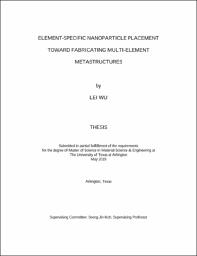
ATTENTION: The works hosted here are being migrated to a new repository that will consolidate resources, improve discoverability, and better show UTA's research impact on the global community. We will update authors as the migration progresses. Please see MavMatrix for more information.
Show simple item record
| dc.contributor.advisor | Koh, Seong Jin | |
| dc.creator | Wu, Lei | |
| dc.date.accessioned | 2019-05-28T23:01:38Z | |
| dc.date.available | 2019-05-28T23:01:38Z | |
| dc.date.created | 2019-05 | |
| dc.date.issued | 2019-05-17 | |
| dc.date.submitted | May 2019 | |
| dc.identifier.uri | http://hdl.handle.net/10106/28164 | |
| dc.description.abstract | Nanoscale entities such as semiconductor nanoparticles, magnetic nanoparticles, metal nanoparticles, and dielectric nanoparticles have attracted a lot of attention due to their novel electrical, optical, and magnetic properties that their bulk materials cannot produce. These unique properties promise applications in nano-optical devices, ultra-sensitive sensors, single electron transistors, and high-density data storages. Moreover, to these captivating properties of the individual nanoparticles, it has been found that novel and scientifically important properties can be obtained when nanoparticles are arranged in specific configurations. Examples include nanoparticle dimers, hexamers, heptamers, and nanoparticle arrays. Until now, however, most studies have focused on one-element nanoparticle systems. This thesis investigates a new approach in which different-element nanoparticles can be placed on target substrate positions to construct multi-element nanoparticle metastructures.
The nanoparticle placement is carried out using electrostatic guiding structure, which guides negatively charged nanoparticles onto desired substrate locations. Placement of different-element nanoparticles is enabled by controlling the electrostatic interactions between different-element nanoparticles and the electrostatic guiding structure. The electrostatic guiding structure was created using E-Beam lithography, thin film deposition, and formation of self-assembled monolayers (SAMs). The guiding structure contained circular wells having varying diameters from 100 nm to 200 nm. Surface modification with self-assembled monolayers (SAMs) created positively and negatively charged areas on the structure. The nanoparticles were made negatively charged by immobilizing DNA on their surfaces. The negatively charged single nanoparticles were guided by the SAMs-functionalized electrostatic guiding structure and placed on the center positions of the circular wells. By controlling the ion concentrations, pH, and circular well diameters, we were able to differentiate the placement of 30 nm and 50 nm Au nanoparticles, enabling the element-specific placement of single nanoparticles. | |
| dc.format.mimetype | application/pdf | |
| dc.language.iso | en_US | |
| dc.subject | Nanoparticles | |
| dc.subject | Nanoparticle array | |
| dc.subject | Multi-element | |
| dc.subject | Electrostatic interactions | |
| dc.subject | Self-assembled monolayers | |
| dc.subject | DNA | |
| dc.title | ELEMENT-SPECIFIC NANOPARTICLE PLACEMENT TOWARD FABRICATING MULTI-ELEMENT METASTRUCTURES | |
| dc.type | Thesis | |
| dc.degree.department | Materials Science and Engineering | |
| dc.degree.name | Master of Science in Materials Science and Engineering | |
| dc.date.updated | 2019-05-28T23:03:48Z | |
| thesis.degree.department | Materials Science and Engineering | |
| thesis.degree.grantor | The University of Texas at Arlington | |
| thesis.degree.level | Masters | |
| thesis.degree.name | Master of Science in Materials Science and Engineering | |
| dc.type.material | text | |
| dc.creator.orcid | 0000-0002-8092-1103 | |
Files in this item
- Name:
- WU-THESIS-2019.pdf
- Size:
- 4.059Mb
- Format:
- PDF
This item appears in the following Collection(s)
Show simple item record


